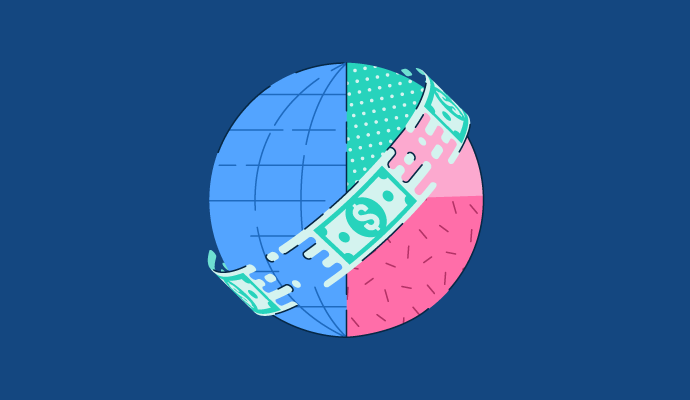Remittances are funds sent from one party to another, such as a bill payment. However, in this article, we discuss remittances as the act of sending money to relatives living abroad for ongoing support, emergencies, or special events.
Remittances account for a significant share of the gross domestic product (GDP) of small and developing countries. In difficult situations such as disasters, or due to social problems such as poverty, remittances help improve people’s living standards.
Financial institutions help remit the money and guarantee it reaches the designated party.Remittance fees vary depending on the remittance method payment processing system. Let’s take a closer look at some of the latest remittance statistics.
Global Remittance Statistics
Global remittances have shown resilience and growth despite economic uncertainty and other geopolitical challenges. Remittance flows continue to increase, reaching new heights in 2023 for low- and middle-income countries.
This drives improvements in the global economy. However, remittance fees remain an issue. It can be up to 6.2% of the transfer amount and varies by region and remittance channel. Study these statistics to get a complete overview.
- Global remittance flows will be US$860 billion in 2023, up from US$836 billion in 2022. It grew by 3% in one year.
77%
Half of global remittance inflows go to low- and middle-income countries.
Source: World Bank
- The US digital remittance market is growing at a compound growth rate of 15.1%. By 2032, this number is likely to reach $13.5 billion.
- In 2020, $508 billion was sent to low- and middle-income countries.
- Global remittances have increased year by year since 2016, but declined in 2020 due to the epidemic.
- Remittances have climbed steadily from US$591 billion in 2016 to US$860 billion in 2023, and are expected to reach US$887 billion in 2024.
Countries that receive the most remittances
India tops the list, followed by Mexico and China in second and third.
These countries have more remittance inflows than outflows, but Australia has significantly larger outflows. Read on to get a clearer picture of remittances by country.
- In 2023, Australia’s remittances to other countries reached US$1.65 billion, with more outflows than inflows.
- In 2023, the Philippines’ total remittances reached US$40 billion, accounting for 9.2% of its GDP.
- Pakistan will receive $24 billion by 2023, accounting for 7% of its GDP.
- In 2022, the UAE remitted $39.67 billion, ranking second after the United States.
3.4%
In 2023, $125 billion ($125 billion) of India’s GDP came from remittances, the highest number in the world.
Source: Business Standard
- Mexico and China received US$67 billion and US$50 billion, ranking second and third respectively.
- In 2023, Nepal received a record remittance of $11 billion, accounting for approximately 26.6% of its GDP.
- In 2023, Malaysia received US$1.75 billion in remittances, with much larger outflows.
- In 2023, South Asia, Latin America, the Caribbean, and East Asia and the Pacific were the largest recipients of these funds, with US$189 billion, US$156 billion, and US$133 billion respectively.
FinTech Remittance Statistics
FinTech Remittances use technology to move money from one country to another, making the process faster and often cheaper than traditional methods.
This technology uses strong security measures to keep your funds safe and your confidential information secure. It helps protect your identity and avoid any misuse. These statistics will provide more context for fintech remittances.
- The transaction value of digital remittance fintech solutions is expected to be $151.3 billion in 2024.
- Fintech remittances from the United States will reach $29.92 billion in 2024.
- Fintech remittance users have grown from 5.33 million in 2017 to 15.82 million in 2024. Major fintech players with significant market shares include Wise, Revolut and Remitly.
- The expected average transaction value per user of the digital remittance market in 2024 is US$9.56 million.
- It is expected that by 2028, the number of users in the digital remittance market will reach 18.85 million.
US remittance statistics
The United States is an important source of remittances globally and has a large immigrant population. Immigrants send billions of dollars back home each year to support their families with basic necessities such as food, medicine, education and health care.
Modern technology has made it easier and cheaper to send money from the United States. The following statistics help us better understand the situation of remittances in the United States.
- The United States received $7.2 billion in remittances in 2023, slightly less than in 2022.
95%
of American remitters send money home to support friends or family. Common reasons include ongoing support, emergency assistance, celebrations, and global events.
Source: International Monetary Fund
- It is expected that by 2028, remittance growth in the United States will reach $32.98 billion. Remitly leads the US market, followed by Wise and Xoom Money Transfer.
Technical Support Remittance
Despite economic turmoil and uncertainty, remittance volumes have grown steadily since 2020. The above statistics illustrate the opportunities in the global remittance market. The cost of remittances may be an area of interest for entrepreneurs and banking institutions.
The market also looks promising for companies building and operating technology that facilitates money transfers. This market needs more players to enter, making this space a rewarding experience for many.
Discover Latest Fintech Statistics To gain more actionable insights into the industry.
